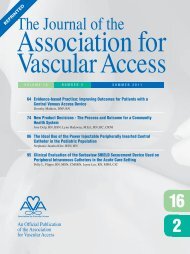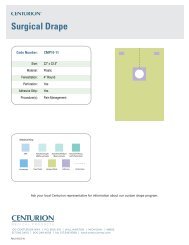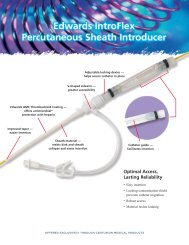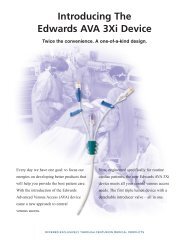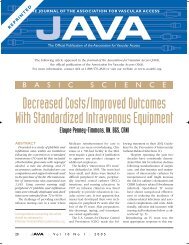What Is The Predominant Source of Intravascular ... - CVCBundle.com
What Is The Predominant Source of Intravascular ... - CVCBundle.com
What Is The Predominant Source of Intravascular ... - CVCBundle.com
Create successful ePaper yourself
Turn your PDF publications into a flip-book with our unique Google optimized e-Paper software.
[7]. This may reflect inadequate time to<br />
properly clean the connectors before accessing<br />
them, inadequate training, or<br />
both. Likewise, a low nurse-to-patient<br />
ratio independently increases the risk <strong>of</strong><br />
catheter infection [8], likely reflecting<br />
lapses in aseptic technique. Similarly, insufficiently<br />
trained nurses working in an<br />
intensive care unit setting independently<br />
increases the risk <strong>of</strong> such infections [9].<br />
Some needleless connectors are associated<br />
with an increased incidence <strong>of</strong><br />
catheter infection, likely from an intraluminal<br />
source [7, 10]. This may be due<br />
to <strong>of</strong> difficulty cleaning the surface <strong>of</strong><br />
some currently marketed connectors, the<br />
inability to disinfect the internal connector<br />
<strong>com</strong>ponents, or behavioral issues,<br />
as noted above, leading to suboptimal<br />
disinfection <strong>of</strong> connectors prior to their<br />
being accessed, or no disinfection at all.<br />
On the other hand, a decreased risk <strong>of</strong><br />
catheter colonization with use <strong>of</strong> needleless<br />
connectors has been found in<br />
some studies [11, 12], suggesting that<br />
there are likely differences in the risk <strong>of</strong><br />
intraluminal contamination and resultant<br />
bloodstream infection among the<br />
devices now in clinical use.<br />
In conclusion, both extraluminal and<br />
intraluminal routes <strong>of</strong> infection are important<br />
in the pathogenesis <strong>of</strong> central<br />
venous catheter–related infections. Soon<br />
after insertion, the extraluminal route <strong>of</strong><br />
infection predominates, whereas the intraluminal<br />
route does so after a more<br />
extended dwell time. Thus, a focus on<br />
catheter insertion will help prevent<br />
CRBS<strong>Is</strong> that occur within days <strong>of</strong> catheterization<br />
and a focus on catheter maintenance<br />
will help prevent later infections.<br />
Behavioral changes reflecting education,<br />
evidence-based catheter insertion, and<br />
maintenance bundle use [13–15], as<br />
well as the promise <strong>of</strong> novel catheter<br />
and connector advances [16, 17],<br />
antimicrobial dressings [18], and catheter<br />
flush solutions [19] will further reduce<br />
risk <strong>of</strong> catheter infections.<br />
Acknowledgments<br />
Partial, unrestricted support was provided by<br />
Catheter Connections, which had no influence<br />
on the content <strong>of</strong> this article.<br />
Finanical support. This work was supported<br />
by Catheter Connections.<br />
Potential conflicts <strong>of</strong> interest. L.A.M. has<br />
received research support from <strong>The</strong>ravance and<br />
Pfizer, and he has served as a consultant for<br />
CorMedix, Ash Access, Semprus, CareFusion,<br />
Catheter Connections, and Sage.<br />
References<br />
1. Safdar N, Maki DG. <strong>The</strong> pathogenesis <strong>of</strong><br />
catheter-related bloodstream infection<br />
with noncuffed short-term central venous<br />
catheters. Intensive Care Med 2004;<br />
30:62–7.<br />
2. Segura M, Lladó L, Guirao X, et al. A prospective<br />
study <strong>of</strong> a new protocol for ‘in situ’<br />
diagnosis <strong>of</strong> central venous catheter related<br />
bacteraemia. Clin Nutr 1993; 12:103–7.<br />
3. Douard MC, Clementi E, Arlet G, et al.<br />
Negative catheter-tip culture and diagnosis<br />
<strong>of</strong> catheter-related bacteremia. Nutrition<br />
1994; 10:397–404.<br />
4. Raad I, Costerton W, Sabharwal U,<br />
Sacilowski M, Anaissie E, Bodey GP. Ultrastructural<br />
analysis <strong>of</strong> indwelling vascular<br />
catheters: A quantitative relationship<br />
between luminal colonization and duration<br />
<strong>of</strong> placement. J Infect Dis 1993; 168:400–7.<br />
5. Dittmer ID, Sharp D, McNulty CA,<br />
Williams AJ, Banks RA. A prospective study<br />
<strong>of</strong> central venous hemodialysis catheter<br />
colonization and peripheral bacteremia.<br />
Clin Nephrol 1999; 51:34–9.<br />
6. Chaiyakunapruk N, Veenstra DL, Lipsky BA,<br />
Saint S. Chlorhexidine <strong>com</strong>pared with povidone-iodine<br />
solution for vascular cathetersite<br />
care: A meta-analysis. Ann Intern Med<br />
2002; 136:792–801.<br />
7. Karchmer TB, Cook EM, Palavecino E, et al.<br />
Needleless valve ports may be associated<br />
with a high rate <strong>of</strong> catheter-related bloodstream<br />
infection [abstract]. In: Program <strong>of</strong><br />
the 15 th Annual Meeting <strong>of</strong> the Society for<br />
Healthcare Epidemiology <strong>of</strong> America (Los<br />
Angeles, CA). Washington, DC: Society for<br />
Healthcare Epidemiology <strong>of</strong> America, 2005.<br />
307.<br />
8. Fridkin SK, Pear SM, Williamson TH,<br />
Galgiani JN, Jarvis WR. <strong>The</strong> role <strong>of</strong><br />
understaffing in central venous catheterassociated<br />
bloodstream infections. Infect<br />
Control Hosp Epidemiol 1996; 17:150–8.<br />
9. Alonso-Echanove J, Edwards JR, Richards MJ,<br />
et al. Effect <strong>of</strong> nurse staffing antimicrobialimpregnated<br />
central venous catheters on the<br />
risk for bloodstream infections in intensive<br />
care units. Infect Control Hosp Epidemiol<br />
2003; 24:916–25.<br />
10. Jarvis WR, Murphy C, Hall KK, et al.<br />
Health care-associated bloodstream infections<br />
associated with negative- or positive-pressure<br />
or displacement mechanical<br />
valve needleless connectors. Clin Infect Dis<br />
2009; 49:1821–7.<br />
11. Bouza E, Muñoz P, López-Rodríguez J, et al.<br />
A needleless closed system device (CLAVE)<br />
protects from intravascular catheter tip and<br />
hub colonization: A prospective randomized<br />
study. J Hosp Infect 2003; 54:279–87.<br />
12. Casey AL, Worthington T, Lambert PA,<br />
Quinn D, Faroqui MH, Elliott TS. A randomized,<br />
prospective clinical trial to assess<br />
the potential infection risk associated with<br />
the PosiFlow needleless connector. J Hosp<br />
Infect 2003; 54:288–93.<br />
13. Sawyer M, Weeks K, Goeschel CA, et al.<br />
Using evidence, rigorous measurement, and<br />
collaboration to eliminate central catheterassociated<br />
bloodstream infections. Crit Care<br />
Med 2010; 38:S292–8.<br />
14. Miller MR, Griswold M, HarrisII JM, et al.<br />
Decreasing PICU catheter-associated<br />
bloodstream infections: NACHRI’s quality<br />
transformation efforts. Pediatrics 2010;<br />
125:206–13.<br />
15. Sannoh S, Clones B, Munoz J, Montecalvo M,<br />
Parvez B. A multimodal approach to central<br />
venous catheter hub care can decrease<br />
catheter-related bloodstream infection. Am<br />
J Infect Control 2010; 38:424–9.<br />
16. Maki DG. In vitro studies <strong>of</strong> a novel antimicrobial<br />
luer-activated needleless connector<br />
for prevention <strong>of</strong> catheter-related<br />
bloodstream infection. Clin Infect Dis 2010;<br />
50:1580–7.<br />
17. Casey AL, Mermel LA, Nightingale P, Elliott<br />
TSJ. Antimicrobial central venous catheters<br />
in adults: A systematic review and metaanalysis.<br />
Lancet Infect Dis 2008; 8:763–76.<br />
18. Timsit JF, Schwebel C, Bouadma L, et al.<br />
Chlorhexidine-impregnated sponges and<br />
less frequent dressing changes for prevention<br />
<strong>of</strong> catheter-related infections in<br />
critically ill adults: A randomized controlled<br />
trial. JAMA 2009; 301:1231–41.<br />
19. Venkatesh M, Rong L, Raad I, Versalovic J.<br />
Novel synergistic antibi<strong>of</strong>ilm <strong>com</strong>binations<br />
for salvage <strong>of</strong> infected catheters. J Med Microbiol<br />
2009; 58:936–44.<br />
Downloaded from cid.oxfordjournals.org by guest on February 23, 2011<br />
212 d CID 2011:52 (15 January) d Mermel




